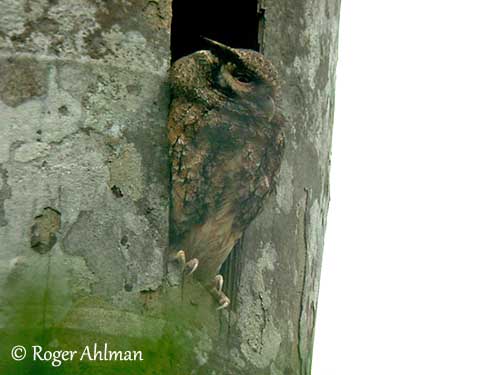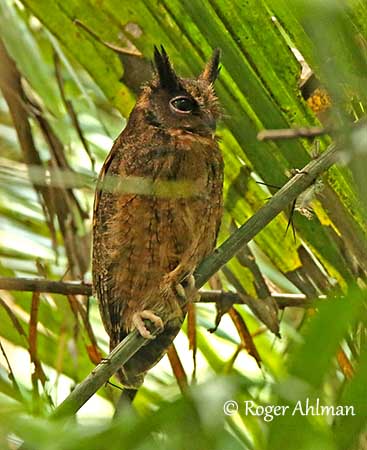
Fr: Petit-duc de Watson
Ang: Tawny-bellied Screech Owl
All: Watsoneule
Esp: Autillo Orejudo
Ita: Assiolo di Watson
Nd: Donkerbruine Schreeuwuil
Port: Corujinha-orelhuda
Photographers:
Roger Ahlman
Pbase Galleries Peru and Ecuador
Didier Buysse
Vision d’Oiseaux
Text by Nicole Bouglouan
Sources:
HANDBOOK OF THE BIRDS OF THE WORLD Vol 5 by Josep del Hoyo-Andrew Elliott-Jordi Sargatal - Lynx Edicions - ISBN: 8487334253
OWLS OF THE WORLD – By Claus König, Friedhelm Weick and Jan-Hendrik Becking - IBSN 978-0-7136-6548-2
A GUIDE TO THE BIRDS OF COLOMBIA by Steven L. Hilty and William L. Brown - Princeton University Press – ISBN 069108372X
Wikipedia, the free encyclopaedia
El Zoológico Electrónico (Damisela)
Tawny-bellied Screech Owl
Megascops watsonii
Strigiformes Order – Strigidae Family
INTRODUCTION:
The screech owls are restricted to the Americas. They were formerly included in the genus Otus, but based on behavioural, biogeographical, morphological and DNA analysis, they are now in their own genus Megascops.
This species is relatively common throughout the range, and usually frequents the interior of lowland rainforest. Like numerous Strigidae, the Tawny-bellied Screech Owl remains in the thick vegetation during the day, because it has nocturnal habits. This species is threatened by heavy deforestation.

DESCRIPTION OF THE BIRD:
Biometrics:
Length: 19-23 cm
Weight: 114-155 g
The adult appears relatively dark. It has greyish-brown upperparts with black and buff spots and vermiculations, and buff wash on the hindneck. This species has indistinct spots on scapulars, sometimes absent. Flight-feathers and rectrices are barred brown and pale buff.
On the underparts, the upper breast is dark brown with small buff spots, but the throat is paler. Centre of lower breast and belly are buff with faint white barring on belly. Rest of underparts is rusty to sandy-brown and streaked with black.
On the head, facial disk and eyebrows are buffy brown with fine dark vermiculations and thin dark border. The ear-tufts are conspicuous and show black outer webs and tips.
The bill is greenish-grey. The eyes are amber-yellow to brownish-orange. The tarsi are well-feathered buff. The feet are pale flesh.
Male and female have similar plumage, but female is slightly larger than male.
The juvenile is not described.
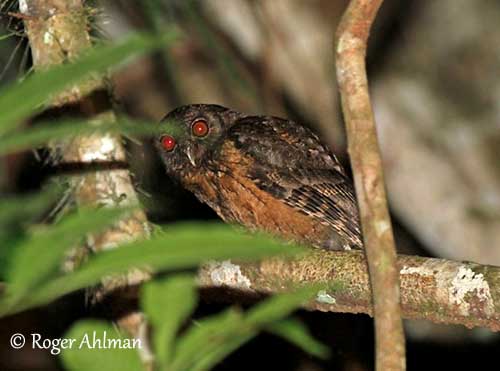
SUBSPECIES AND RANGE:
The Tawny-bellied Screech Owl has two subspecies.
M.w. watsonii (here described and displayed) or Northern Tawny-bellied Screech Owl is found in lowlands from E Colombia, S to NE Peru and E (N of Amazon River) to French Guiana and Amazonian Brazil.
M.w. usta or Southern Tawny-bellied Screech Owl occurs in E Peru and S Amazonian Brazil, S to lowland forest of N Bolivia and N Mato Grosso.
This race is slightly larger than nominate (23-24 cm long). It has similar pattern and rufous plumage overall with broad streaks on the underparts. This race has two morphs. The dark morph is browner, blackish-brown above and tawny-buff below. The light morph is rare. It is buffer and has much paler underparts.
HABITAT:
The Tawny-bellied Screech Owl inhabits the interior of lowland humid forests, and can be seen sometimes in clearings or at forest edges. This species occurs up to 600 metres of elevation, but it is reported up to 2100 metres in the Perijá Mountains.
The race “usta” frequents the tropical primary lowland forest along rivers, and lives usually at lower level (30 metres) in primary forest or second growth.
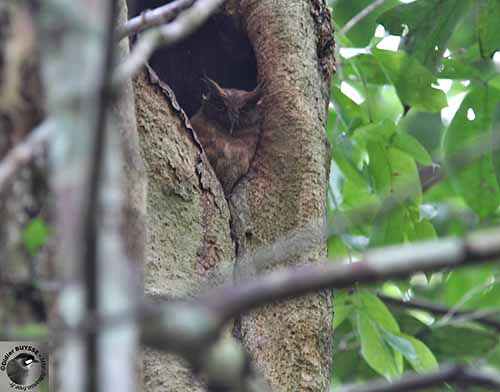
CALLS AND SONGS: SOUNDS BY XENO-CANTO
The first song of the male is a long series of rapid notes, starting softly, increasing in volume and fading at the end “bubububububububu…”
The second song is a short sequence of notes in staccato rhythm. The first song is given at night while the second song is uttered at dusk. The female produces higher-pitched sounds.
The race “usta” has similar primary song with 2-3 notes per second “whoo-whoo-whoo-whoo-whoo…”
The second song is a series of bouncing notes which start rapidly and becomes slower at the end “bububu-bu-bu-bu-bu-bu bu bub”.

BEHAVIOUR IN THE WILD:
The Tawny-bellied Screech Owl feeds primarily on insects, but it probably takes small vertebrates too, caught from the lower levels. It feeds on large insects including beetles, moths, grasshoppers and cicadas, and these items are the largest part of its diet. Small vertebrates such as rodents are probably taken too.
It uses its hooked bill and the sharp claws to tear the prey into pieces before to swallow them. It hunts from perch and detects the prey thanks to its good sense of hearing.
The breeding behaviour of the Tawny-bellied Screech Owl is poorly known. The male builds a nest in a cavity from which it tries to attract a female. The selection by the female is based on the quality of the nesting cavity and of the food items located inside.
During the courtship displays, the male calls from several different branches while approaching the female. Then, it bobs the head and later, its entire body. If the female accepts the male, they touch their bills and engage in mutual preening. They are monogamous with long-term pair-bonds.
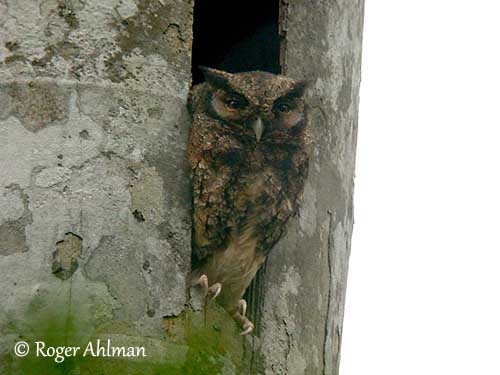
The Tawny-bellied Screech Owl is resident in its range.
Like numerous Strigidae, this species has silent flight allowing it to catch the preys by surprise.
REPRODUCTION OF THIS SPECIES:
The breeding season is usually related to prey availability and starts in early spring.
The Tawny-bellied Screech Owl nests in natural cavities such as holes in dead or living trees. It also uses abandoned nests of other species, usually woodpeckers. The same nest-site is often reused in several following years.
The female lays 3-4 eggs and does most of the incubation during about 25-26 days. The male defends the nest and a small territory around the cavity. It also feeds the female during the incubation.
The chicks are fed by the female with small pieces of food. Usually, only one chick survives, due to predation. It fledges one month after hatching.
This species produces a single brood per season, but a second brood can be laid if the first is lost.
PROTECTION / THREATS / STATUS:
The Tawny-bellied Screech Owl is threatened by heavy deforestation within its range. The population size has not been quantified, but although being described as “common”, the numbers are suspected to decline. This species occurs in several protected areas.
The Tawny-bellied Screech Owl is currently evaluated as Least Concern.
